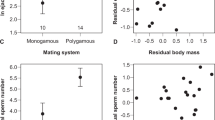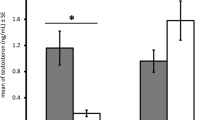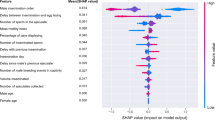Abstract
Paternity is often determined by competition between the ejaculates of different males1. Males can also use particular behaviours or structures to manipulate how females use sperm2,3,4,5. However, the ability of females to bias sperm utilization in favour of preferred males independently of male manipulation has not been demonstrated6. Females are predicted to respond differentially to the sperm of different males when the reproductive interests of the sexes differ and when females are coerced into copulating4,6. Here we show that in female feral fowl most copulations are coerced, and that females consistently bias sperm retention in favour of the preferred male phenotype. Females prefer to copulate with dominant males, but when sexually coerced by subordinate males, they manipulate the behaviour of dominant males to reduce the likelihood of insemination. If this fails, females differentially eject ejaculates according to male status in the absence of any male manipulation and preferentially retain the sperm of dominant males.
This is a preview of subscription content, access via your institution
Access options
Subscribe to this journal
Receive 51 print issues and online access
$199.00 per year
only $3.90 per issue
Buy this article
- Purchase on Springer Link
- Instant access to full article PDF
Prices may be subject to local taxes which are calculated during checkout

Similar content being viewed by others
References
Parker, G. A. Sperm competition and its evolutionary consequences in the insects. Biol. Rev. 45, 525–567 ( 1970).
Davies, N. B. Polyandry, cloaca-pecking and sperm competition in dunnocks. Nature 302, 334–336 ( 1983).
Otronen, M. Mating behavior and sperm competition in the fly, Dryomyza anilis. Behav. Ecol. Sociobiol. 26, 349– 356 (1990).
Eberhard, W. G. Female Control: Sexual Selection by Cryptic Female Choice (Princeton Univ. Press, Princeton, 1996).
Edvardsson, M. & Arnqvist, G. Copulatory courtship and cryptic female choice in red flour beetles Tribolium castaneum. Proc. R. Soc. Lond. B 267, 559–563 (2000).
Birkhead, T. R. Cryptic female choice: criteria for establishing female choice of sperm. Evolution 52, 1212–1218 (1998).
Darwin, C. The Descent of Man, and Selection in Relation to Sex (Murray, London, 1871).
Wiley, H. R. & Poston, J. Indirect mate choice, competition for mates, and coevolution of the sexes. Evolution 50, 1371–1381 (1996).
Clutton-Brock, T. H. & Parker, G. A. Sexual coercion in animal societies. Anim. Behav. 49, 1345 –1365 (1995).
Pizzari, T. Reproductive strategies in feral fowl, Gallus gallus. Thesis, Univ. Sheffield (1999).
Jones, M. J. J. & Mench, J. Behavioral correlates of male mating success in multisire flocks as determined by DNA fingerprinting. Poultry Sci. 70, 1493– 1498 (1991).
Cheng, K. M. & Burns, J. T. Dominance relationship and mating behavior of domestic cocks—a model to study mate-guarding and sperm competition in birds. Condor 90, 697– 704 (1988).
Craig, J. V., Ortman, L. L. & Guhl, A. M. Genetic selection for social dominance ability in chicks. Anim. Behav. 13, 114– 131 (1965).
Allen, T. E. & Grigg, G. W. Sperm transport in the fowl. Aust. J. Agr. Res. 8, 788–799 (1957).
Thornhill, R. in Sperm Competition in Birds: Evolutionary Causes and Consequences (eds Birkhead, T. R. & Møller, A. P.) 82 (Academic, London, 1992).
Etches, R. J. Reproduction in Poultry (CAB International, Oxon, 1996 ).
Sokal, R. R. & Rohlf, J. F. Biometry 2nd edn (W. H. Freeman and Company, New York, 1981).
Parker, J. E., McKenzie, F. F. & Kempster, H. L. Fertility in the male domestic fowl. Univ. Miss. Agric. Exp. Station Bull. 347, 1– 50 (1942).
Simmons, L. W. Sperm competition as a mechanism of female choice in the field cricket Gryllus bimaculatus. Behav. Ecol. Sociobiol. 21 , 197–202 (1987).
Clark, A. G., Begun, D. J. & Prout, T. Female × male interactions in Drosophila sperm competition. Science 283, 217– 220 (1999).
Zeh, J. A. & Zeh, D. The evolution of polyandry II: post-copulatory defences against genetic incompatibility. Proc. R. Soc. Lond. B 264, 69–75 ( 1997).
Birkhead, T. R., Martinez, J. G., Burke, T. & Froman, D. Sperm mobility determines the outcome of sperm competition in the domestic fowl. Proc. R. Soc. Lond. B 266, 1759– 1764 (1999).
Cunningham, E. J. A. & Cheng, K. M. Biases in sperm use in the mallard: no evidence for selection by females on sperm genotype. Proc. R. Soc. Lond. B 266, 905– 910 (1999).
Martin, P. A., Reimers, T. J., Lodge, J. R. & Dziuk, P. J. The effect of ratios and numbers of spermatozoa mixed from two males on proportions of offspring. J. Reprod. Fertil. 39, 251 –258 (1974).
Sheldon, B. C. Sexually transmitted disease in birds: occurrence and evolutionary significance. Proc. R. Soc. Lond. B 39, 491– 497 (1993).
Chapman, T., Liddle, L. F., Kalb, J. M., Wolfner, M. F. & Partridge, L. Cost of mating in Drosophila melanogaster females is mediated by male accessory gland products. Nature 373, 241–244 ( 1995).
Harrison, B. Den Svenska dvärghönan. II. Sven. Rasf. Tidskrift 1, 12–14 (1987).
Clutton-Brock, T. H., Albon, S. D., Gibson, R. M. & Guinness, F. E. The logical stag: adaptive aspects of fighting in red deer (Cervus elaphus L.). Anim. Behav. 27, 211– 225 (1979).
Ishikawa, H. The life duration of cock spermatozoa outside the body. Proc. World Poult. Fourth Congr. 90–94 ( 1930).
Bakst, M. R. & Cecil, H. C. (eds) Techniques for Semen Evaluation, Semen Storage, and Fertility Determination (Poultry Sci. Assoc., Savoy, 1997).
Acknowledgements
We thank N. Andbjer, A. Bylin and C. K. Cornwallis for technical assistance, S. Jakobsson for providing facilities, A. P. Balmford, T. A. Burke, N. B. Davies, B. J. Hatchwell, F. M. Hunter, C. M. Lessells and P. J. Warren for comments. T.P. was supported by a Patrick & Irwin Packington Fellowship and T.R.B. by a grant from the National Environmental Research Council.
Author information
Authors and Affiliations
Corresponding author
Rights and permissions
About this article
Cite this article
Pizzari, T., Birkhead, T. Female feral fowl eject sperm of subdominant males. Nature 405, 787–789 (2000). https://doi.org/10.1038/35015558
Received:
Accepted:
Issue Date:
DOI: https://doi.org/10.1038/35015558
This article is cited by
-
Ranking parameters driving siring success during sperm competition in the North African houbara bustard
Communications Biology (2023)
-
Encounter with heavier females changes courtship and fighting efforts of male field crickets Gryllus bimaculatus (Orthoptera: Gryllidae)
Journal of Ethology (2022)
-
Strategic adjustment of ejaculate quality in response to variation of the socio-sexual environment
Behavioral Ecology and Sociobiology (2021)
-
3D printed spermathecae as experimental models to understand sperm dynamics in leaf beetles
BMC Zoology (2020)
-
Ultrasonic signals associated with different types of social behavior of mice
Nature Neuroscience (2020)
Comments
By submitting a comment you agree to abide by our Terms and Community Guidelines. If you find something abusive or that does not comply with our terms or guidelines please flag it as inappropriate.



